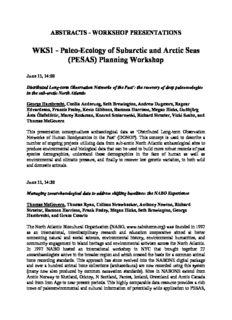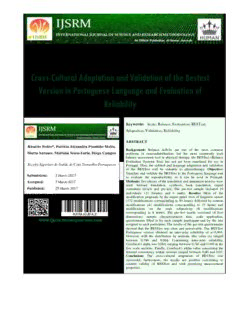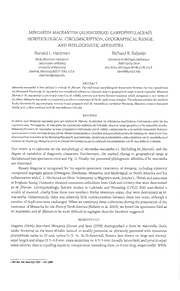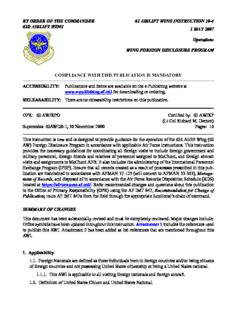
Paleo-Ecology of Subarctic and Arctic Seas PDF
Preview Paleo-Ecology of Subarctic and Arctic Seas
ABSTRACTS - WORKSHOP PRESENTATIONS WKS1 - Paleo-Ecology of Subarctic and Arctic Seas (PESAS) Planning Workshop June 11, 14:00 Distributed Long-term Observation Networks of the Past’: the recovery of deep paleoecologies in the sub-arctic North Atlantic George Hambrecht, Cecilia Anderung, Seth Brewington, Andrew Dugmore, Ragnar Edvardsson, Francis Feeley, Kevin Gibbons, Ramona Harrison, Megan Hicks, Guðbjörg Ásta Ólafsdóttir, Marcy Rockman, Konrad Smiarowski, Richard Streeter, Vicki Szabo, and Thomas McGovern This presentation conceptualizes archaeological data as ‘Distributed Long-term Observation Networks of Human Ecodynamics in the Past’ (DONOP). This concept is used to describe a number of ongoing projects utilizing data from sub-arctic North Atlantic archaeological sites to produce environmental and biological data that can be used to build more robust records of past species demographics, understand these demographics in the face of human as well as environmental and climatic pressure, and finally to recover lost genetic variation, in both wild and domestic animals. June 11, 14:20 Managing zooarchaeological data to address shifting baselines: the NABO Experience Thomas McGovern, Thomas Ryan, Colleen Strawhacker, Anthony Newton, Richard Streeter, Ramona Harrison, Frank Feeley, Megan Hicks, Seth Brewington, George Hambrecht, and Grace Cesario The North Atlantic Biocultural Organization (NABO, www.nabohome.org) was founded in 1992 as an international, interdisciplinary research and education cooperative aimed at better connecting natural and social science, environmental history, environmental humanities, and community engagement in island heritage and environmental activism across the North Atlantic. In 1997 NABO hosted an international workshop in NYC that brought together 27 zooarchaeologists active in the broader region and which created the basis for a common animal bone recording standards. This approach has since evolved into the NABONE digital package and over a hundred animal bone collections (archaeofauna) are now recorded using this system (many now also produced by common excavation standards). Sites in NABONE extend from Arctic Norway to Shetland, Orkney, N Scotland, Faroes, Iceland, Greenland and Arctic Canada and from Iron Age to near present periods. This highly comparable data resource provides a rich trove of paleoenvironmental and cultural information of potentially wide application to PESAS, NorFish, and allied efforts to better mobilize the records of the past to serve the future by addressing the widely recognized “shifting baselines” pathology. However, the NABO data sets are currently not easily searchable and need organization and the application of a modern cutting edge data discoverability and access system. This system is now under development through an NSF-funded CyberARC project led by Colleen Strawhacker of NSIDC with the zooarchaeological component led by Tom Ryan of CUNY. This paper provides an overview of the NABONE resources and the ongoing development of new data discoverability tools aimed at better mobilizing this resource. WKS2 - Climate change impacts on nearshore fish habitats in the Arctic June 11, 09:00 Predicting Barents Sea fish stocks from upstream hydrographic variability Anne Britt Sandø, Marius Årthun, Ute Daewel, Corinna Schrum, Noel Keenlyside and Bjarte Bogstad Marine ecosystem dynamics are a complicated interplay between physical and biological factors. Fish stocks are furthermore affected by both management and environmental factors and, hence, are inherently difficult to predict. Here, we have however shown that it is possible to predict a significant part of interannual fish stock variability in the Barents Sea based on upstream hydrographic variability several years in advance. A discussion of the mechanisms of interactions between fish stocks and temperature has not been the focus here. Rather, we have assessed to what extent observed upstream hydrography can be used to predict Barents Sea fish stocks and identified the most skillful hydrographic predictors. Other studies have identified other potential predictors for fish stocks in the Barents Sea, although with a shorter prediction horizon. In conclusion, we have demonstrated that changes in Barents Sea fish stocks are to a large extent associated with a lagged response to temperature changes observed in the subpolar North Atlantic which propagate northward along the Atlantic water pathway towards the Barents Sea. The associated time lag enables skillful predictions of Barents Sea fish stocks several years in advance and could provide valuable advice on fisheries management. The importance of upstream hydrography to fish stocks warrants continued monitoring of the Norwegian Atlantic Current and its extension into the Barents Sea. June 11, 09:20 Arctic cod in the Russian Arctic: new data from the Siberian seas Natalia Chernova There is increasing interest in nearshore processes and their influence on fish biota in the Arctic. The key fish species in the entire Arctic is the Polar (or Arctic) cod Boreogadus saida. It is the most numerous species and important in food chains of cold-water ecosystems. The life cycle of the species is rather well known for the Barents Sea populations but the biology and migration of the polar cod from the Siberian seas are poorly known at present. I will present the results of large-scale trawl surveys in which I participated. Transects on the western shelf of the Kara Sea (2012, August-September) included about 174 demersal and 107 pelagic trawling stations. Transects in the Laptev Sea and neighboring East-Siberian waters (2014, August-October) included about 166 demersal and 120 pelagic trawling stations. Boreogadus results will be presented. These data provide a baseline that may help to understand processes in nearshore Arctic fish communities under climate change. June 11, 09:40 Towards a process based understanding of climate change consequences on ecosystems Trond Kristiansen, Charles Stock, Michael Alexander, Øystein Varpe, Anne Hollowed, Kirstin Holsman, Ken Drinkwater and Elizabeth Selig Ocean variability has long been known to show strong decadal and multi-decadal variability that significantly affects the weather and climate of the North Atlantic and Pacific Oceans as well as the Arctic Ocean. Past observations of ecosystem responses to climate variability can provide an overall understanding of how future climate change will impact marine resources. Here, we consider how four large marine ecosystems (LMEs), the southeast Bering Sea, the Northeast US Shelf, the Norwegian Sea, and the Barents Sea differ in their response to climate change and how the local processes play important roles in shaping the interactions between physics and biology. Particularly, we focus on how these selected ecosystems have historically responded to climate variability and discuss some of the implications future climate change may have on these systems. We also analyze how the physical properties of each of these ecosystems are expected to change in the future and discuss possible consequences for the marine ecology such as primary production, functional diversity, and ecosystem composition. Finally, we discuss key areas of future research including how to use a mechanistic framework to more quantitatively assess how key ecosystem processes will be impacted by climate change. June 11, 10:00 A decade in review: Physical conditions structuring annual variation in nearshore Arctic forage fish communities Johana Vollenweider, Ron Heintz, Mark Barton, Kevin Boswell, Leandra Sousa, Alexei Pinchuk The Arctic nearshore offers critical ecosystem services to an abundance of juvenile forage fish. These unique habitats will be impacted differently than offshore habitats from effects of reduced sea ice, increased wind storms, oil drilling, shipping, infrastructure development, coastal erosion, and terrestrially-derived freshwater. We characterize the abundance and community composition of nearshore Arctic forage fish in relation to oceanographic and physical habitat features structuring annual variability over the span of a decade. Specifically, we conducted beach seine sampling from 2004 to 2015 at the same 10 locations every August in three distinct water bodies near Barrow, Alaska, including the Chukchi and Beaufort Seas, and Elson Lagoon. Catches fluctuated between dominance of either Arctic cod (Boreogadus saida) or capelin (Mallotus villosus), with several species of sculpin consistently present. Along with fish sampling, we made concurrent measurements of sea surface temperature and salinity. Additional physical habitat examined in our analysis include wind speed and direction, sea-ice conditions, and the large-scale climate Arctic Oscillation Index. Understanding the physical conditions which support proliferation of different Arctic fish species will be important in predicting future productivity in the Arctic. June 11, 10:50 Seasonality in nearshore habitats near Pt. Barrow, AK Ron Heintz, Mark Barton, Kevin Boswell, Seth Danielson, C. Li, Brenda Norcross, Alexei Pinchuk, Leandra Sousa and Johana Vollenweider The region around Point Barrow, Alaska is an ideal location examining how warming conditions will influence nearshore ecosystems at high latitudes. Point Barrow is an oceanographically dynamic location demarking the boundary between the Chukchi and Beaufort Seas. Freshwater outflows from Elson Lagoon, just to the east of Point Barrow on the Beaufort Sea coast, contribute to the dynamism. We sampled the fish communities residing there by beach seining during the ice-free period from 2013-2015. Sampling was conducted weekly and our goal was to obtain baseline information on seasonal changes in the community composition, age structure, diets and trophic status. Within years, species richness increased in the weeks following ice retreat and catches were dominated by age-0 fish. The most frequently encountered taxa included cottids, slender eelblenny, Arctic shanny, capelin, Pacific sand lance, and gadids. Temperature and salinity covaried between years so that there was much greater habitat variability in warm years. Winds influence salinity by forcing fresh water out of the lagoon or retaining it in the lagoon. Coincidently, catches were highest in warm years. The energy density of the fish was consistent across years and generally lower than observed in conspecifics collected farther offshore. We found the region around Pt. Barrow to be complex and speciose. It serves as an important nursery area for juvenile forage fish and continued warming is certain to influence its current status. June 11, 11:10 Thermal growth condition determines the productivity of coastal nursery habitat for juvenile cod Benjamin Laurel, David Cote, Robert Gregory, Lauren Rogers, Halvor Knutsen, and Esben Moland Olsen Coastal regions are considered to be important nursery habitat for many cod species in the Sub- Arctic and Arctic, yet they are highly dynamic in terms of seasonal and annual temperature variation that could impact growth and survival. We analyzed coastal time-series from the Gulf of Alaska, Newfoundland and Norway to test the hypotheses that the thermal growth potential of juvenile cod (Atlantic cod Gadus morhua, Pacific cod Gadus macrocephalus and Greenland cod Gadus ogac) provides some indication of survival likelihood in the first year of life under varying temperature regimes. Results indicated a strong positive link with growth potential and survival, with poor survival linked to low growth potential from cold winters (Newfoundland) and recent warmer summers (Norway). We conclude that temperature-dependent growth strongly influence the productivity of coastal habitats among regions, and temporal changes in growth potential (e.g., via climate change) will likely impact habitat quality by way of size-dependent mortality or spatial shifts to deeper, offshore areas. June 11, 11:30 A comparison of temporal trends in fish community structure of three sub-Arctic coastal areas David Cote, Caren Barcelo, Benjamin Laurel, and Robert Gregory Coastal marine ecosystems are extremely productive and serve as important nursery areas for many commercially important species. Unfortunately, these systems are also extremely vulnerable to anthropogenic perturbations, including climate shifts. Comparisons of long term monitoring data from sub-Arctic coastal areas in Bonavista Bay, Newfoundland (since 1996), Kodiak Island, Alaska (since 2006) and Skagerrak, Norway (since 1919) suggest that juvenile gadid recruitment may be strongly linked to area-specific growth conditions. While all of the study areas are under the influence of climate change, the growth potential and the corresponding response of resident gadids differs across areas. Fish community data are also available for each of the study areas, where directional temporal shifts in community structure (including the arrival of new species, declines in overall species richness and biomass) are evident. This contribution aims to compare the nature of fish community shifts and assess whether they mirror the findings of single-species gadid recruitment studies. June 11, 13:30 Heterogeneity in zooplankton communities near the Alaskan Arctic coast and the resulting effects on planktivorous fish feeding habits Alexei Pinchuk Nearshore environment plays an important role in the Arctic ecosystem providing vital habitat for a variety of organisms including numerous anadromous and marine fishes. We synthesized data on composition and distribution of zooplankton, fish diets and physical processes that may influence pelagic communities in the coastal Chukchi and Beaufort seas to address the following fundamental questions: how do variable oceanographic conditions structure zooplankton communities near the Alaskan Arctic coast during ice-free summer time, and how may planktivorous predators benefit from these changes? Nearshore zooplankton assemblages on the seaward side of the coast were strongly influenced by the strength of the buoyancy-driven Alaska Coastal Current (ACC) inhabited by numerous small copepods. Strong and persistent northeasterly winds appeared to arrest ACC flow and promote advection of large lipid-rich Arctic zooplankton into the nearshore, where they became a preferred prey for Arctic cod. An abundant brackish-water (<20 PSU) community dominated by copepod Limnocalanus macrurus/grimaldii developed in the stratified waters far inside Elson Lagoon during summer. These lipid-rich copepods are an excellent source of energy for euryhaline predators capable of tolerating low salinity, but, probably, are inaccessible to true marine species. The duration and success of the Limnocalanus production season may be important to survival and year-class strength of cisco (Coregonus spp.) juveniles, which perform ontogenetic migration from tundra lakes and rivers to estuarine nursery areas each summer after spawning. June 11, 13:50 TBA Xénia Weber June 11, 14:10 Tissue turnover rates and trophic discrimination in Arctic sculpin (Myoxocephalus scorpioides): A new perspective on Arctic trophic dynamics Mark Barton, Kevin Boswell, Ron Heintz, Johanna Vollenweider, and Brenda Norcross As the impacts of climate change and anthropogenic activities become increasingly pervasive in the Arctic, so does the need for a comprehensive baseline with which to compare and contrast changing ecosystem dynamics. Recent studies have used stable isotope analysis to investigate trophic structures and pathways within several Arctic marine environments. Controlled lab-based isotope experiment have shown that the parameters used in food web models are more complex than early works had indicated, and yet very few controlled experiments have been used to identify appropriate parameters for Arctic species. We carried out a controlled lab-based isotope study on a common Arctic nearshore fish species, the Arctic sculpin (Myoxocephalus scorpioides), to determine tissue turnover rates and trophic discrimination factors. This experiment indicated that sculpin livers, muscle and fin have slow isotope turnover rates for δ13C (93, 129, And 126 days, respectively) and δ15N (115, 129, and 166 days, respectively). Trophic discrimination factors were high for δ13C (2.5 to 3 ‰), and low for δ15N (1.5 to 3 ‰). We propose these parameters be used for Arctic fish species in food web models and discuss the theoretical implications for future isotope studies. June 11, 14:30 The interaction of temperature and diet quality in determining the condition of juvenile saffron cod (Eleginus gracilis) and Arctic cod (Boreogadus saida): results from combined laboratory and field based approaches Louise Copeman and Benjamin Laurel Climate models indicate the Arctic will undergo dramatic environmental change with increased global warming. These effects will likely be the most severe in nearshore waters that serve as nursery habitat for juvenile gadids throughout Alaska. Increasing temperatures will likely be coupled with changes in freshwater input that will in turn significantly affect nearshore marine food webs. Both Arctic cod (Boreogadus saida) and saffron cod (Eleginus gracilis) are ecologically important in Alaskan coastal waters, however, little is known about their growth, feeding ecology or energy allocation during the juvenile stage. We used both field and laboratory approaches to understand the early energetics of juvenile Arctic and saffron cod in relation to changes in temperature and food availability. Field collections of age-0 and age-1 juvenile gadids showed significant trends in condition metrics both within and between species. Both species showed increased lipid per wet weight with standard length up until the first over-wintering period. Arctic cod had higher levels of total lipids and storage lipids in both muscle and liver tissues than Saffron cod. Energetic differences, both within and among these gadids, may stem from regional trophic and thermal conditions. Fatty acid biomarkers indicate Arctic cod have a higher reliance on Calanoid copepods than saffron cod and laboratory experiments show distinct differences in growth and lipid storage under varying temperatures. These data suggest Arctic cod and saffron cod will likely respond differently to regional nearshore warming, such that energetic contribution of these forage fish to higher trophic levels could be transformed in the wake of further climate change. June 11, 14:40 Trophic vulnerability of 0-group Atlantic cod (Gadus morhua) and saithe (Pollachius virens) A case study investigating the juveniles’ feeding pattern and identifying valuable nursery habitats in the Icelandic Westfjords Anja Nickel Rapid environmental change due to anthropogenic impacts currently threaten marine ecosystems and increase the pressure on the vulnerable early life stages of many marine organisms. In this study, I examine trophic vulnerability of 0-group Atlantic cod (Gadus morhua) and saithe (Pollachius virens) during late summer and fall. This period coincides with the Atlantic cod juvenile settlement from the pelagic to the benthic habitat in the northwest of Iceland. It is a critical period for both species as growth in the first summer and fall may determine winter survival. Results from previous studies have identified clear habitat preferences of juvenile gadoids for structured habitats such as maerl beds and macro-algae. In Iceland, both habitat types are exploited and affected directly and indirectly by anthropogenic activities. In the current study, I investigate the diets of 0-group cod and saithe juveniles and discuss the relevance of trophic preferences and trophic competition for nursery ground conservation and management. The feeding patterns of the 0-group juveniles revealed that both species are opportunistic feeders with a wide range of prey organisms. Despite that, there is high overlap in the foraging niche of cod and saithe, suggesting the potential for trophic competition between and within the two species. Juveniles of both species exhibited similar feeding patterns during most of the study time. During the sampling period from late July until November, the proportion of benthic prey items gradually shifted until the diet mainly contained pelagic organisms. From late October on, cod and saithe feeding patterns started to diverge, which indicates more specialized foraging habits. 0-group saithe were larger throughout the sampling period. The results of the current study emphasize the need for further research investigating the early life stages of exploited fish species and the implementation of management measures for their nursery grounds in coastal waters. WKS3 - Using natural analogues to investigate the effects of climate change and ocean acidification on northern ecosystems June 11, 10:00 Investigating local and regional adaptation using natural analogues of climate change Peter Thor Organisms maintain their function through a myriad of physiological regulation processes. Many of these processes are involved in buffering changes in the outside environment. Accordingly, marine organisms will have to response physiologically to future changes in temperature and pH in the face of global change. The vast majority of empirical studies assessing biological effects employ acute tests in which organisms are exposed during very short periods of time. These tests fail to register the full effect of a changing environment. They do not test for long term evolutionary effects such as adaptation, parental effects, and various kinds of transgenerational effects. A series of different studies have circumvented these shortcomings by employing natural analogues of global change. Some of these show that populations may react to changes through adaptation but also by phenotypic plasticity (acclimatisation). Thus, when using this approach, care should be taken to properly separate effects of evolutionary changes and phenotypic plasticity. June 11, 11:20 Applying CO seep approaches to other natural analogues of ocean acidification 2 Jason M. Hall-Spencer and Marco Milazzo We have been involved with many projects using natural gradients in seawater carbonate saturation to assess the effects of ocean acidification in the Mediterranean. Observations at CO2 seeps off Ischia, Methana and Vulcano have shown very similar effects of acidification at the ecosystem level. We will describe the types of colonization and transplant experiments that have worked well to reveal the mechanisms that cause changes in microalgal, macroalgal and sessile invertebrate communities. We have also carried out work on more motile organisms such as phytoplankton, meroplankton and fish. Most regions of the planet do not have coastal CO2 seeps but there are great opportunities for using other types of natural gradients in carbonate chemistry to determine responses to acidification, such as fjords and upwelling areas to assess regional responses. In this workshop talk we will explore the baseline physicochemical surveys needed to establish natural analogue sites and the sorts of experiments and observations that can work well (and what to avoid!) at such locations. June 11, 14:00
Description:The list of books you might like

Haunting Adeline

Better Than the Movies

The Subtle Art of Not Giving a F*ck

The Silent Patient

La Matrix Europea: Il piano di conquista degli uomini del Bilderberg in Italia

Introdução ao JSON

Flat-Coated Retriever

Büchi’s Monadic Second Order Successor Arithmetic

Memorabilia

Caracterización de capacidades

c - Alaska District

Healthcare operations management

C: A linguagem de programação - Padrão Ansi

BİR ARAP MİLLİYETÇİSİ REŞÎD SELÎM EL-HÛRÎ, HAYATİ VE ŞİİRİ

ABS Census 1991, Census Characteristics Of Tasmania

T 28091-Analisis pengembangan-Literatur

CALIFORNIA STATE UNIVERSITY, NORTHRIDGE AQUATIC EXERCISE MANUAL FOR ...

Nesting Biology of a Tropical Myrmicine Ant, Myrmicaria arachnoides (Formicidae), in West Java, Indonesia






